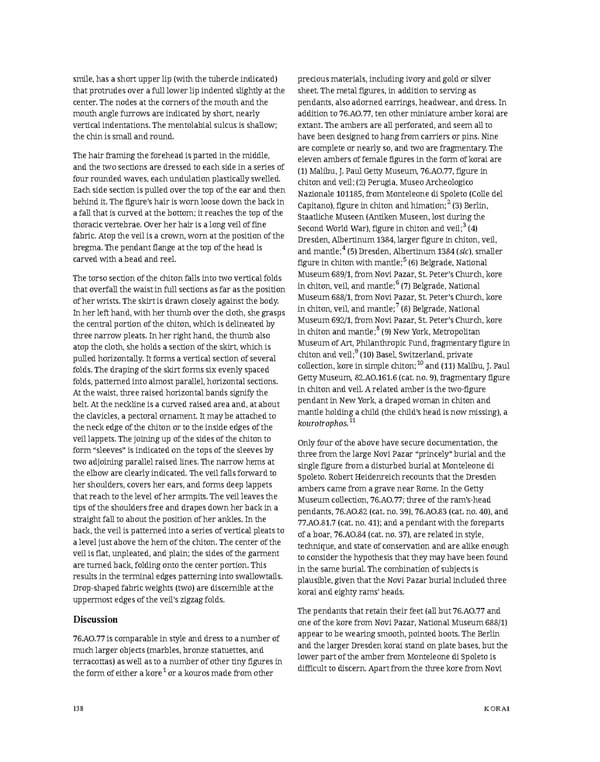smile, has a short upper lip (with the tubercle indicated) precious materials, including ivory and gold or silver that protrudes over a full lower lip indented slightly at the sheet. The metal figures, in addition to serving as center. The nodes at the corners of the mouth and the pendants, also adorned earrings, headwear, and dress. In mouth angle furrows are indicated by short, nearly addition to 76.AO.77, ten other miniature amber korai are vertical indentations. The mentolabial sulcus is shallow; extant. The ambers are all perforated, and seem all to the chin is small and round. have been designed to hang from carriers or pins. Nine are complete or nearly so, and two are fragmentary. The The hair framing the forehead is parted in the middle, eleven ambers of female figures in the form of korai are and the two sections are dressed to each side in a series of (1) Malibu, J. Paul Getty Museum, 76.AO.77, figure in four rounded waves, each undulation plastically swelled. chiton and veil; (2) Perugia, Museo Archeologico Each side section is pulled over the top of the ear and then Nazionale 101185, from Monteleone di Spoleto (Colle del behind it. The figure’s hair is worn loose down the back in Capitano), figure in chiton and himation;2 (3) Berlin, a fall that is curved at the bottom; it reaches the top of the Staatliche Museen (Antiken Museen, lost during the thoracic vertebrae. Over her hair is a long veil of fine Second World War), figure in chiton and veil;3 (4) fabric. Atop the veil is a crown, worn at the position of the Dresden, Albertinum 1384, larger figure in chiton, veil, bregma. The pendant flange at the top of the head is and mantle;4 (5) Dresden, Albertinum 1384 (sic), smaller carved with a bead and reel. figure in chiton with mantle;5 (6) Belgrade, National The torso section of the chiton falls into two vertical folds Museum 689/1, from Novi Pazar, St. Peter’s Church, kore in chiton, veil, and mantle;6 (7) Belgrade, National that overfall the waist in full sections as far as the position of her wrists. The skirt is drawn closely against the body. Museum 688/1, from Novi Pazar, St. Peter’s Church, kore in chiton, veil, and mantle;7 (8) Belgrade, National In her left hand, with her thumb over the cloth, she grasps the central portion of the chiton, which is delineated by Museum 692/1, from Novi Pazar, St. Peter’s Church, kore in chiton and mantle;8 (9) New York, Metropolitan three narrow pleats. In her right hand, the thumb also atop the cloth, she holds a section of the skirt, which is Museum of Art, Philanthropic Fund, fragmentary figure in chiton and veil;9 (10) Basel, Switzerland, private pulled horizontally. It forms a vertical section of several 10 folds. The draping of the skirt forms six evenly spaced collection, kore in simple chiton; and (11) Malibu, J. Paul folds, patterned into almost parallel, horizontal sections. Getty Museum,82.AO.161.6(cat. no. 9), fragmentary figure At the waist, three raised horizontal bands signify the in chiton and veil. A related amber is the two-figure belt. At the neckline is a curved raised area and, at about pendant in New York, a draped woman in chiton and the clavicles, a pectoral ornament. It may be attached to mantle holding a child (the child’s head is now missing), a kourotrophos.11 the neck edge of the chiton or to the inside edges of the veil lappets. The joining up of the sides of the chiton to Only four of the above have secure documentation, the form “sleeves” is indicated on the tops of the sleeves by three from the large Novi Pazar “princely” burial and the two adjoining parallel raised lines. The narrow hems at single figure from a disturbed burial at Monteleone di the elbow are clearly indicated. The veil falls forward to Spoleto. Robert Heidenreich recounts that the Dresden her shoulders, covers her ears, and forms deep lappets ambers came from a grave near Rome. In the Getty that reach to the level of her armpits. The veil leaves the Museum collection, 76.AO.77; three of the ram’s-head tips of the shoulders free and drapes down her back in a pendants, 76.AO.82 (cat. no. 39), 76.AO.83 (cat. no. 40), and straight fall to about the position of her ankles. In the 77.AO.81.7 (cat. no. 41); and a pendant with the foreparts back, the veil is patterned into a series of vertical pleats to of a boar, 76.AO.84 (cat. no. 37), are related in style, a level just above the hem of the chiton. The center of the technique, and state of conservation and are alike enough veil is flat, unpleated, and plain; the sides of the garment to consider the hypothesis that they may have been found are turned back, folding onto the center portion. This in the same burial. The combination of subjects is results in the terminal edges patterning into swallowtails. plausible, given that the Novi Pazar burial included three Drop-shaped fabric weights (two) are discernible at the korai and eighty rams’ heads. uppermost edges of the veil’s zigzag folds. Discussion The pendants that retain their feet (all but 76.AO.77 and one of the kore from Novi Pazar, National Museum 688/1) 76.AO.77 is comparable in style and dress to a number of appear to be wearing smooth, pointed boots. The Berlin much larger objects (marbles, bronze statuettes, and and the larger Dresden korai stand on plate bases, but the terracottas) as well as to a number of other tiny figures in lower part of the amber from Monteleone di Spoleto is the form of either a kore1 or a kouros made from other difficult to discern. Apart from the three kore from Novi 138 KORAI
 Ancient Carved Ambers in the J. Paul Getty Museum Page 147 Page 149
Ancient Carved Ambers in the J. Paul Getty Museum Page 147 Page 149